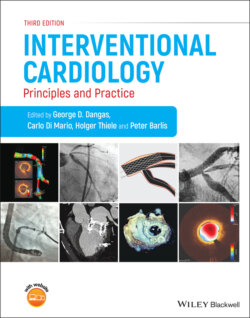Читать книгу Interventional Cardiology - Группа авторов - Страница 266
Trials and current guidelines
ОглавлениеCTA has been proven to have high NPV and can be used safely to rule out acute coronary syndrome (ACS) to expedite discharge in low to intermediate risk patients presenting with acute chest pain [1] [35–40]. The use of CTA as the initial screening test for CAD has remained somewhat controversial due to its tendency to overestimate disease severity. Two large trials of symptomatic patients referred for CAD evaluation are the PROMISE and the SCOT‐HEART trials [41, 42]. The PROMISE trial randomized symptomatic patients to CTA testing or functional testing and found no significant difference in clinical outcomes (composite of death, MI hospitalization for unstable angina or major procedural complication) over a median period of two years. The SCOTHEART trial randomized patients to standard care plus CCTA or standard care alone and at 5 years, found a significantly lower rate of death from coronary heart disease or myocardial infarction in the CCTA group. There was an initial increase in the rate of procedures in the CCTA group but there was no difference between the two groups at the end of five years. The authors concluded that since CTA was shown to be more accurate in diagnosing coronary obstruction in both SCOTHEART and PROMISE, their results implied that PCIs were more appropriately performed in the CCTA group. Additionally, SCOTHEART encouraged initiation of secondary prevention strategies in patients with non‐obstructive disease and the proportion of patients receiving this was higher in the CTA group because of lack of recognition in the usual care group. The 5‐year outcomes of the SCOTHEART trial are very encouraging with regards to the use of CCTA in the assessment of stable ischemic heart disease. On account of its high sensitivity and cost‐effectiveness, the updated 2016 NICE guidelines [43] now recommend the use of coronary CT as the initial screening test for all patients with stable angina. Additionally, a recent trial randomized patients presenting with NSTEMI to an initial ICA, CMR or CTA strategy and found that while fewer procedures occurred in the latter two groups with unchanged one‐year clinical outcomes – implying that CTA or CMR could possibly serve as gatekeepers to ICA in low‐risk NSTEMI as well [44].
